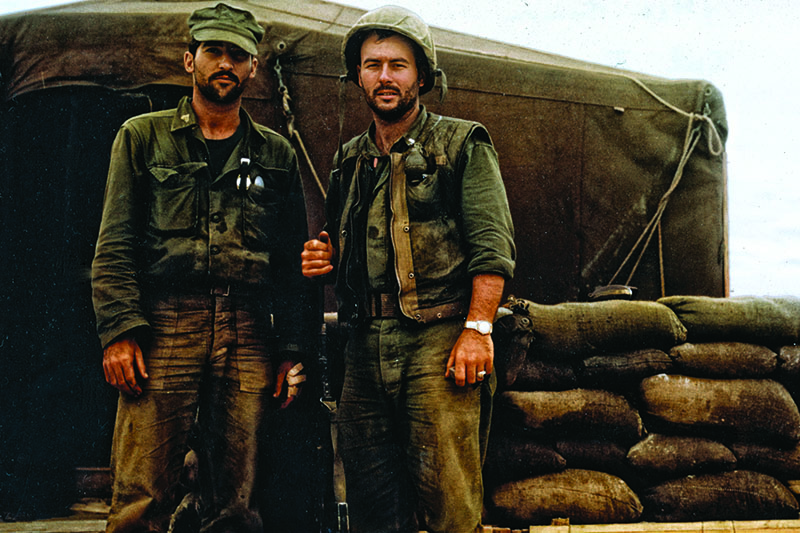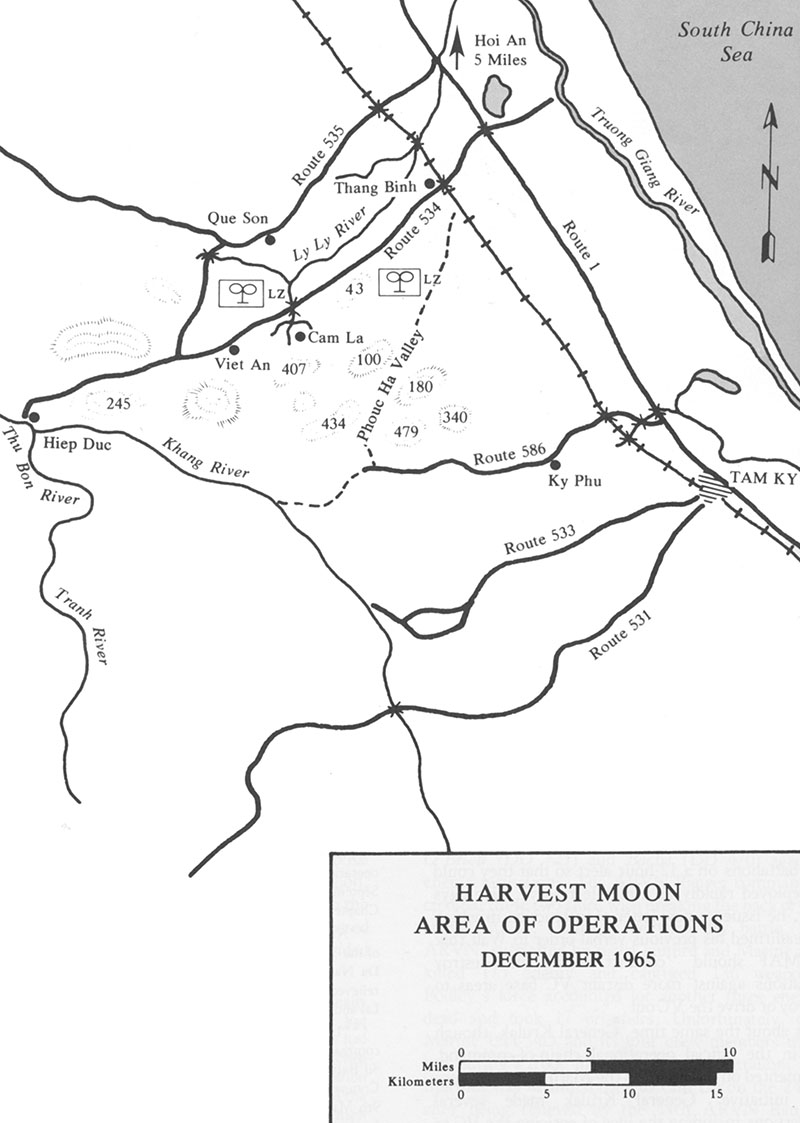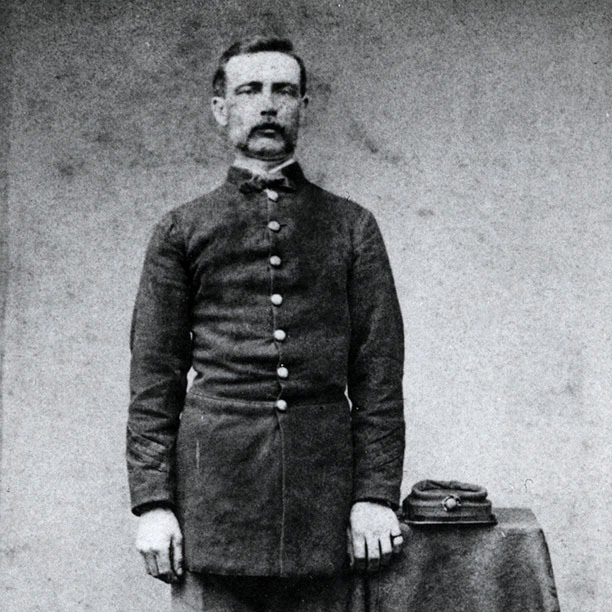It was Dec. 18, 1965, and First Lieutenant Harvey “Barney” Barnum maneuvered east along a dirt road that crossed hills of dense jungle and wound around flooded rice paddies of the Quế Sơn Valley with the rest of Company H, 2nd Battalion, 9th Marine Regiment. The road was designated Route 586, but no vehicle could traverse it.
According to Nicholas J. Schlosser’s pamphlet titled “In Persistent Battle” about Operation Harvest Moon, Barnum had arrived in Vietnam 10 days earlier and was designated Co H’s artillery forward observer. His deployment was a 90-day temporary duty assignment from his duty station at Marine Barracks Pearl Harbor, Hawaii. In 1965, the Marine Corps sent company-grade officers and senior en-listed for three-month deployments to Vietnam to gain combat experience and lessons learned to share with their home units. Marine Barracks Pearl Harbor had only one allotment available, and as the only bachelor among the officers, Barnum volunteered so the others could spend the holidays with their families. The rest of Company H had been in Vietnam for five months already and were expected to be there after his tour ended. Despite being the newly assigned forward observer in an experienced infantry company, Barnum would bring them to safety from the brink of annihilation over the next few hours.
Company H was serving as the rear element in 2nd Battalion, 7th Marine Regiment’s column movement along Route 586 as part of Operation Harvest Moon. Co H was attached to 2/7 to replace the beleaguered Co E, 2/7 on Dec. 13 after combat casualties and immersion foot made the company combat ineffective, according to Schlosser. In the days since, they had covered more than 30 kilometers of flooded roads and paddies on foot. On Dec. 18, the battalion planned to reach Route 1 by nightfall, before all visibility would be lost due to the thick cloud cover of a winter monsoon. They expected this to be the last day of the operation and that the trucks awaiting them at Route 1 would bring 2/7 to Chu Lai and Co H back to Da Nang.
Operation Harvest Moon, which intended to clear the 1st Viet Cong Regiment from the Quế Sơn Valley, had begun 11 days earlier. With brigade-strength task forces of U.S. Marines and Army of the Republic of Vietnam (ARVN) soldiers, this was the largest combined operation of the conflict to date, according to “U.S. Marines In Vietnam: The Landing And The Buildup, 1965,” by Dr. Jack Shulimson and Maj Charles M. Johnson. Unfortunately, the operation did not go as planned. In the first two days, am-bushes by the 1st Viet Cong Regiment reduced the combat power of one ARVN battalion by one-third in only 15 minutes and overran another ARVN regiment, killing their regimental commander. By the third day, the Marine Corps task force commander was relieved and cooperation between the Marine Corps and ARVN deteriorated, according to Schlosser.
However, the operation continued, and Barnum and the rest of Co H trudged on. For the Marines, the weather was the greatest enemy of the operation so far. Despite a resupply of thousands of socks, many Marines suffered immersion foot. After months of jungle hiking, their boots were rotting away. So were their chafed feet. Company E 2/7 evacuated 54 Marines for immersion foot before Company H 2/9 attached to the battalion. Barnum later recalled in a Congressional Medal of Honor Society interview that when he first heard gunfire ahead, “I didn’t think much of it.” The main body of the column had reached the small market town of Ky Phu—only 9 km before Route 1. Around 1:30 p.m., the previously distant gunfire erupted along the column. The battalion had experienced sniper fire in the days prior, but this was different. This was a well-coordinated ambush of the entire battalion.
Two companies of the 1st Viet Cong Regiment stretched 1,000 yards in entrenched, well-camouflaged positions. Movement by 2/7 halted in the face of the sudden barrage of machine-gun fire. The lead element in the column, Co G, established a defensive position east of Ky Phu as they started to receive mortar fire. Fortunately, many of the mortar rounds sank into the muck around them. After days of rain, the saturated soil made the fire much less effective, according to Schlosser. Viet Cong snipers, however, were undeterred and killed several Co G radio operators in the opening minutes of the ambush.

The battalion commanding officer, Lieutenant Colonel Leon Utter, lost contact with much of the battalion as the radio operators were killed. In the turmoil, some radio traffic went out on the wrong nets and the battalion’s column started to separate. Two platoons of Co F were sent to relieve Co G in the defensive positions east of Ky Phu. The rear guard, Co H, however, was still about 500 meters west of the village. Two Viet Cong companies attacked from north and south of the road to exploit this gap. When the attack intensified on the western perimeter of the village, Co F was ordered back west.
As Co F raced west, the VC unleashed a flurry of fire upon Co H. Effective rifle, heavy machine-gun, recoilless rifle and mortar fire from entrenched and camouflaged positions curtailed any movement from Co H. In a 2021 interview with the Department of Veterans Affairs, Barnum recalled, “The enemy knew what the hell they were doing, and it was hellacious.” He first sent a call for fire to the artillery battery to take out the machine-gun emplacement on their right flank. The enemy positions were so close, he said, that “the first fire mission I call[ed] was in on that trench line. The first rounds we took some ‘shrapmetal’ in our positions.” Barnum ceased fire after two rounds. He could only adjust fire for missions that weren’t overhead because the targets were at the battery’s maximum range and the missions were dangerously close.
Meanwhile, Barnum saw Hospital Corpsmen Wesley “Doc Wes” Berrard streak by, yelling, “The skipper’s down! The skipper’s down!” About 50 yards ahead, he saw a pile of Marines. Among them were Co H Commanding Officer, Captain Paul L. Gormley Jr., and his radio operator, Lance Corporal Savoy. Fifty-seven millimeter recoilless rifle fire hit them in the opening salvos of the ambush. Doc Wes was shot several times in his dash to the CO. So was the artillery scout sergeant, Private First Class McClain, who followed him.
Barnum was still adjusting artillery fire when he realized that in a matter of moments, the company CO, radio operator, corpsman and scout sergeant were all down ahead of him. Now Barnum raced forward, but it was too late to help Savoy—he was already dead. Barnum carried Gormley back to a covered position as the firefight continued all around him. He had been with the company for a matter of days. Now the commanding officer was dying in his arms.
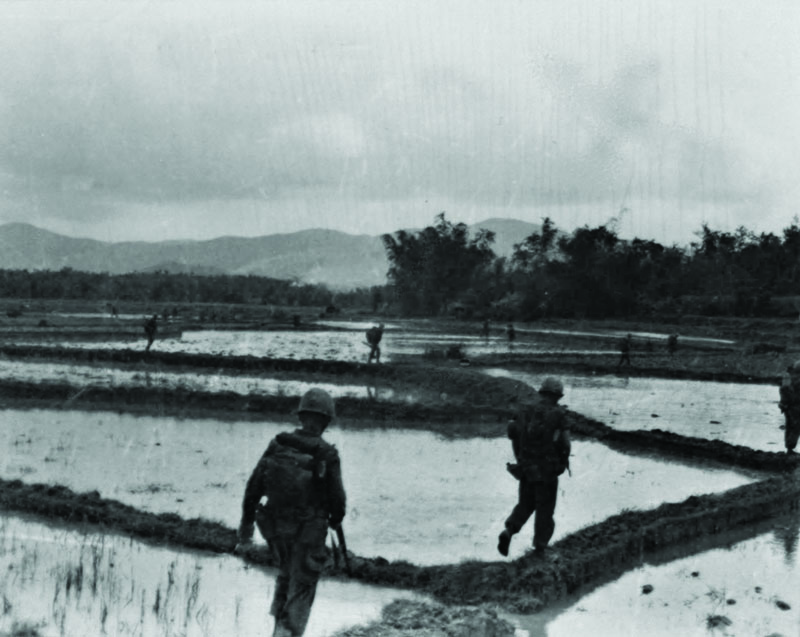
Back at Ky Phu, the battalion began establishing defensive positions around the village. Company H, however, remained pinned down 500 meters away, with a dead commanding officer and radio operator and no radio connection to the leadership.
All around Barnum, the platoon commanders of Co H were in their own firefights. As he held his dead CO, he realized that the radio was still out there. To reestablish communications with the battalion and provide direction to the company, he had to retrieve it. Barnum raced back to Savoy’s body and slung the radio (and its telltale 3-foot antenna) onto his back. He later explained in an interview, “I think the PRC-25 saved our lives.” He immediately contacted Lieutenant Colonel Utter to report the situation, to which Utter replied, “Young man, it sounds like you have a grasp of the situation. Make sure everyone knows you’re the skipper.”

Utter also warned, “Lieutenant, you’ve gotta come on out. We can’t come get you. We’re in our own fight in here. Can’t come out and get you. It’s getting dark. If you don’t fight your way out, you’re there by yourself tonight.” Barnum was the only artilleryman in the company of infantrymen, but he was now the one in command. He later reflected, “When I took over that company, they didn’t even know my name, but I had a bar on my collar and they knew that lieutenants were supposed to give orders. So when I started giving orders, they did exactly what I tasked them to do.” He was grateful that he was only three years out of The Basic School, where every Marine Corps officer is trained in the principles of leading as an infantry platoon commander.
Barnum needed to evacuate the dead and wounded and break through the enemy ambush to rejoin 2/7 in Ky Phu. He recalled, “These young Marines who were pinned down and scared, all they wanted was someone to give them direction. And when I started doing things, they got motivation going. So, at that point, I launched a counterattack on that trench line to our right.” The consequences of command soon weighed on Barnum. “I just got four Marines wounded, and I turn to the next four and say, ‘OK, it’s your turn,’ ” he relayed in an interview with the VA. But he maintained his composure and continued to lead: “We mounted a charge, and I led it. I didn’t say, ‘Go get ’em,’ I said, ‘Follow me.’ And I took off and they were right behind me.”
Now one enemy machine gun was out of action, but the attack continued unrelenting. An hour and a half after the ambush began, close air support arrived: three UH-1E Iroquois, armed with 3.5 mm rockets. Barnum put his experience as a forward observer to good use. His first target was a nearby trench line. He marked it with white phosphorus and talked the pilots onto the target. Barnum continued marking targets until he ran out of white phosphorus, and then, according to Schlosser, he “stood up there and was pointing with [his] arms outstretched at the targets, and the chopper pilots flew down the axis of [his] arms at the targets.”
Company H rallied under Barnum’s leadership. Slowly, they fought back the attack and established a defensive position around a small hill north of the road. Barnum still had to manage an evacuation, so he sent engineers out to blow down trees to make space for a landing zone. After four hours of fighting, they were still repelling the ambush south of the road but had prepared a landing zone on the north side. Barnum explained in his Congressional Medal of Honor Society interview, “Doc Wes was shot five or six times, and he would not let us evacuate him. … He was still giving instructions on how to handle the other cases that were serious and he was the last one he would let me put on a helicopter. … He got shot for the seventh time, but he lived.” Company H’s defense of the landing zone ensured the UH-34 Seahorses evacuated all of the company’s dead and wounded.
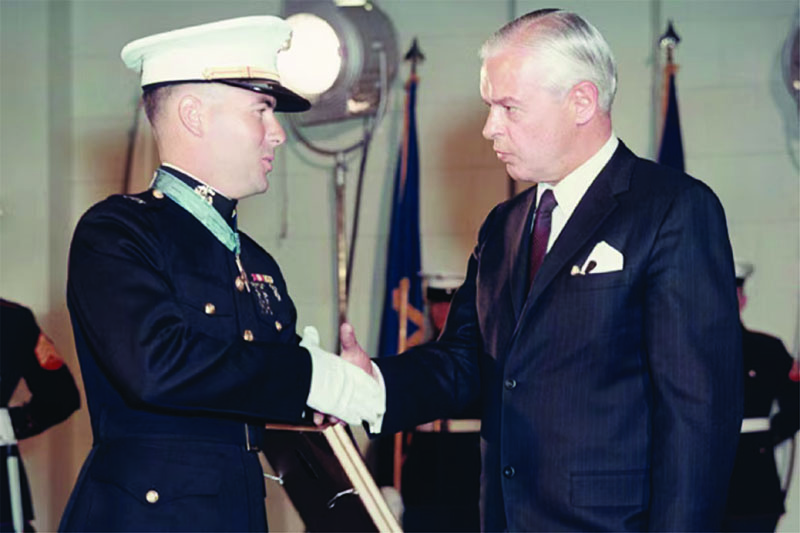
Barnum and the company still had those 500 meters of open rice paddies to cross under heavy fire to rejoin the rest of the battalion in Ky Phu. It was over a quarter of a mile of hell for Co H. Barnum collected all the inoperable radios, ma-chine guns and other equipment, and he had his engineers destroy them to lighten the load. Next, he had the company drop their packs in a pile to burn them. Barnum explained to the company, “Marines don’t leave anybody on the battlefield. Someone drops, you pick him up and bring him with you. So that’s the reason I made you light.”
Relying on his early training, Barnum started moving the company across the rice paddy in fire team rushes. He soon realized that he would never maneuver the entire company across the dike while still receiving intensive fire. Barnum contacted 2/7 and had them provide a base of fire so that he could rush squad by squad across the dike. As each new squad prepared to rush, he told them, “You run as fast as you can. Don’t even stop. The only time you stop is if someone gets shot and you pick them up.” It took almost an hour, but Co H made it into Ky Phu before dark.
Two days later, Co H returned to 2/9, and an infantry officer was assigned command. Shortly after, Barnum was informed that Lieutenant General Walt, III Marine Amphibious Force Commander, had nominated him for the Medal of Honor. Just over 14 months later, Secretary of the Navy Paul Nitze presented Barnum with the medal at a ceremony at Marine Barracks Washington, D.C.
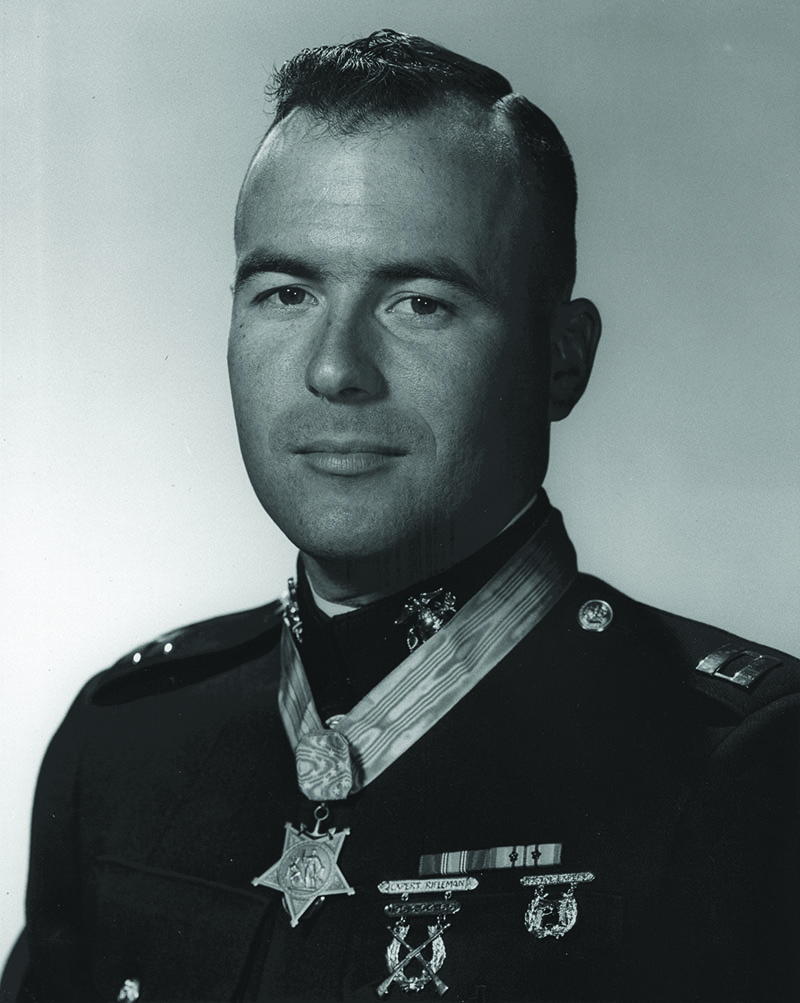
Barnum served in the Marine Corps for another 24 years. In that time, he returned to Vietnam to command Battery E, 2nd Battalion, 12th Marine Regiment; taught at The Basic School; commanded 2nd Battalion, Recruit Training Regiment, Parris Island, S.C., and served as Chief of Operations, U.S. Central Command, among many other assignments. After the Marine Corps, his life of service continued as the principal director of Drug Enforcement Policy, Office of the Secretary of Defense; assistant secretary of the Navy for Reserve Affairs; acting assistant secretary of the Navy (Manpower and Reserve Affairs) and in leadership positions with several nonprofits.
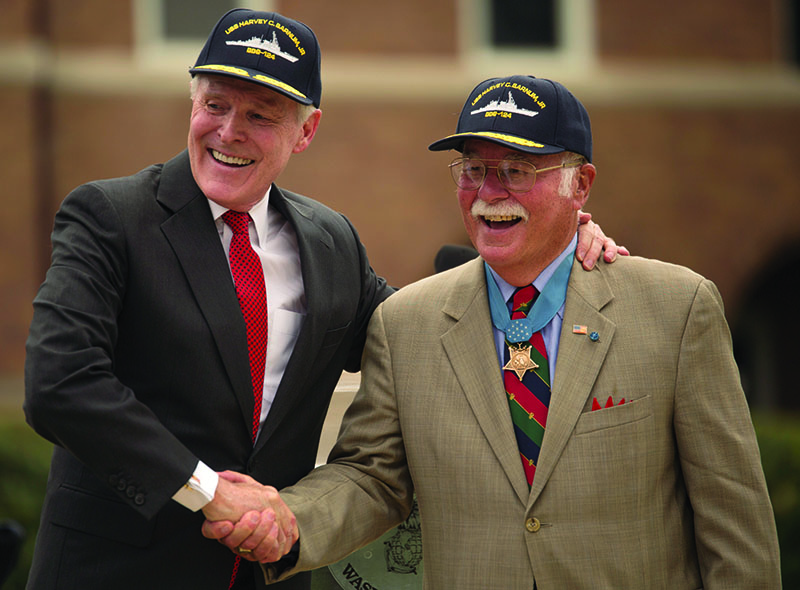
Barnum’s quick action, composure and sound leadership saved the lives of over 130 Marines and corpsmen of Co H on Dec. 18, 1965. In the Congressional Medal of Honor Society interview, Barnum reflected on that day, explaining that he wears his Medal of Honor “in honor of those corpsmen and young Marines that I had the opportunity to lead on the field of battle that day. And anytime I put this medal on, I think of them. And any actions I do or decisions I make, I make it in their name.”
Author’s bio: William J. Prom was a Marine Corps artillery officer from 2009-2014 and now serves as Development Director for the nonprofit veteran service organization, NextOp. He is the 2022 U.S. Naval Institute Naval History Author of the Year, and his work has appeared in Naval History and Proceedings.
Featured Image (Top): Radio operator Cpl Patrick Iacunato, left, and 1stLt Harvey “Barney” Barnum pose for a photo together on Dec. 20, 1965, two days after Barnum’s actions during Operation Harvest Moon, which resulted in the Medal of Honor.


